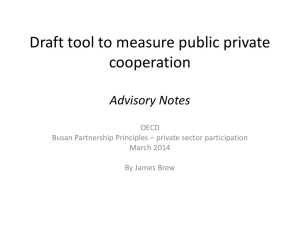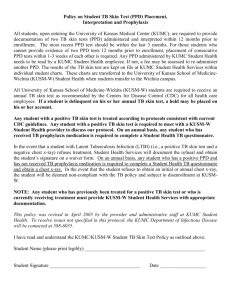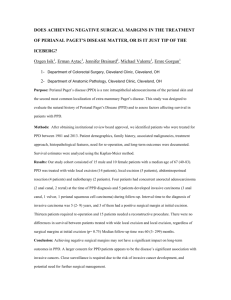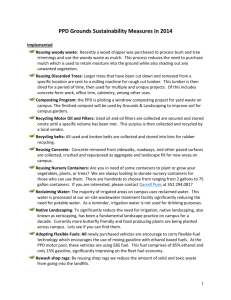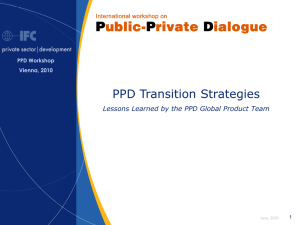- Digital Education Resource Archive (DERA)
advertisement
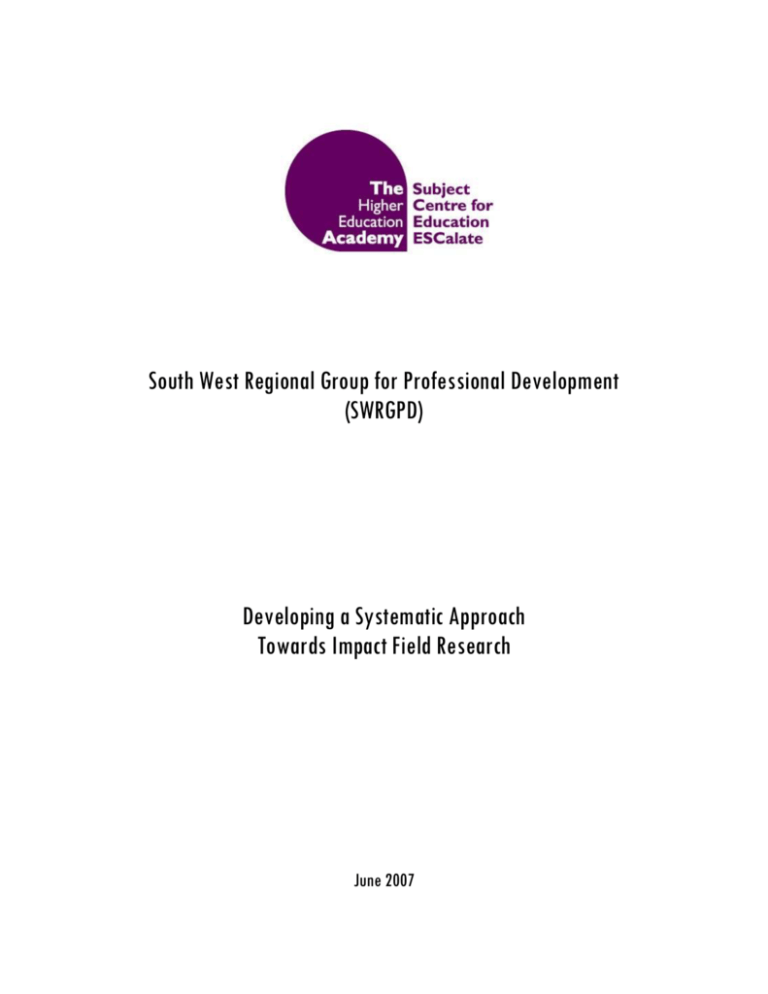
South West Regional Group for Professional Development (SWRGPD) Developing a Systematic Approach Towards Impact Field Research June 2007 Contents Item Page 1. Introduction The historical assessment of Impact A definition of impact Issues relating to the measurement of impact The issue of ‘change’ The National perspective of impact 2 2. Analysis 9 3. Commentary 17 4. Final Discussion 20 5. References 23 2 1. Introduction It is necessary to begin with a review of research into the field of Continuing Professional Development (CPD) and its impact on participants, schools and pupils. This Introduction provides a brief overview and summary of issues most relevant to current questions concerning the evaluation of CPD impact. The historical assessment of Impact The Ofsted report (2004) highlighted the impact of Award-bearing INSET courses: ‘in bringing about significant improvements to a number of areas in their schools, including; standards of pupils’ work; teaching; pupil assessment and target setting; curriculum planning; implementation of national strategies; and systems for review and self-evaluation’. This report also highlighted the fact that: ‘almost all providers monitor the impact of the training on participants and their schools but only a minority try to assess longer-term change. Few monitor or assess the impact of courses on the standard of pupils’ work’. In answer to this issue the Training and Development Agency (TDA) have now introduced the requirement that all providers applying for its new Postgraduate Professional Development (PPD) funding (which replaces the Award- bearing INSET funding) must be able to: ‘Provide specified management information, and include an evaluation of the programme’s impact on practice in schools’ The requirement for assessment of impact has previously been required of providers engaged in the Award – bearing INSET programme, however, this programme was monitored through Ofsted inspection. In the case of the PPD programme there is a requirement for an annual report from each provider which focuses on management information and the impact of provision at the three levels of: participant, school and pupil. The formalisation of this requirement has led to a significant shift in the PPD sector with providers engaging in much deeper discussions addressing the measurement of the ‘impact’ of the programme. A definition of impact The assessment of ‘impact’ is not as easy as it may at first seem. The definition of ‘impact’ has itself proved in the literature to be somewhat problematic. Early 1990 publications from the Department of Science and Education initially used the notion of ‘INSET effectiveness’ rather than using the term impact. The issue with this is that ‘different stakeholders mean different things when they talk about effectiveness’ (Flecknoe and Saeidi, 1999). The same issue arises with the term ‘impact’. The term is interpreted variously by stakeholders adopting different perspectives and drawing on different sorts of evidence. A number of researchers have proposed typology’s to try to frame the effects of INSET, and thereby give some definition of impact in relation to CPD. Harland and Kinder (1997) built on existing models of outcomes from Joyce and Showers (1980) and Fullan (1991). They propose the following nine point typology of INSET outcomes. 3 1. Material and provisionary outcomes – these are the physical resources which result from participation in INSET activity. Their research shows that such outcomes can have a positive and substantive influence on teachers’ classroom practice. They do suggest that ensuring an impact on practice would usually require intermediary outcomes such as motivation and new knowledge and skills. In comparison to Fullan’s (1991) model they retain a distinction between ‘provisionary’ and ‘practice’ outcomes in the sense that impact on material and provisionary outcomes can be achieved without impact on actual practice, and that impact on classroom practice may be dependent on achievement of provisionary and material outcomes. 2. Informational outcomes – these are the state of being briefed or cognisant of background facts and news about curriculum and management developments, including their implications for practice These outcomes remain distinct from new knowledge and skills which imply a more critical and deeper understanding. It is considered that these outcomes will have little impact on classroom practice. 3. New awareness – this involves a perceptual shift from previous assumptions of what constitutes the appropriate content and delivery of a particular curriculum area. Their research corroborated teachers’ own perceptions that changed awareness are no guarantee of changed practice. For there to be an impact their research showed that their needed to be value congruence. 4. Value congruence – this refers to the personalised versions of curriculum and classroom management which inform a practitioner’s teaching and how far the individual codes of practice coincide with the INSET providers’ messages of ‘good practice’. Their research showed that tying value congruence with the INSET message was a crucial factor in influencing subsequent classroom implementation. Where the values of the curriculum coordinators attending the course were compatible with those of the course leaders, there was an increased likelihood of impact on classroom practice. It was acknowledged that stimulating and sustaining shifts in positions was a very difficult outcome to accomplish. This became specifically apparent where ‘cascading’ to colleagues in school was attempted and the school-based colleagues did not have the same beliefs as the course leader. Here it appeared that tensions arose specifically as a result of differences in value congruence. 5. Affective outcomes – these acknowledge that there is an emotional dimension inherent in any learning situation. The research highlighted that affective outcomes could be both positive and negative. Initial positive outcomes could be short-lived without a sense of accompanying enhanced expertise associated with them: e.g., enhanced knowledge and skills. It is recognised that affective outcomes may be the precursor for changing practice and that the design of CPD should achieve positive affective outcomes (and avert negative ones) as much as possible. 6. Motivational and attitudinal outcomes – refer to enhanced enthusiasm and motivation to implement the ideas received during the INSET experience. 4 These may lead to changes in teachers’ attitudes towards their self-concept and professional identity, amongst others. It is recognised that they are an important precondition to developments in practice but that they may be short-lived and superficial if not accompanied by other outcomes. 7. Knowledge and skills - refers to the development of deeper levels of understanding, critical reflexivity and theoretical rationales with regards to curriculum content and pedagogy. Eraut’s (1994) analysis of different kinds of professional knowledge and understanding has highlighted that the characteristics of effective CPD may vary both according to the broad types of outcome but also according to the various forms of knowledge. It may therefore be that ‘in order to define the qualities of effective CPD, it may be necessary to relate different modes and formats of CPD to a subset of the knowledge and skills outcome type’. 8. Institutional outcomes – this acknowledges that INSET can have a collective impact on groups of teachers and their practice. 9. Impact on practice – this recognises the intention to bring about changes in practice, either directly or through the indirect route of the other outcomes discussed At this point it should be noted that as Harland and Kinder report, the ultimate aim of this typology is ‘to bring about changes in practice’ and not to directly indicate increases in pupil achievement. Any causal relationship between changed practice and changes in pupil achievement therefore remains to be identified. The Harland and Kinder paper goes on to develop a hierarchy of outcomes based on the research which highlights that the ‘presence of certain outcomes was more likely to achieve developments in practice than others’. A second model relating to outcomes of training is the Joyce and Showers 1980 model. Joyce and Showers present the following framework of outcomes: 1. 2. 3. 4. Awareness of new skills; Concepts and organisation of underlying concepts and theories, ordering knowledge; Development of new skills; Application of concepts, principles and skills to practice. This paper moves on to discuss the components of training in relation to their outcomes. The table devised by Joyce and Showers identifies which forms of training are best suited to bring about the specified outcomes above. Joyce and Showers (1988) presented further findings focusing on measurement of ‘effect size’ on pupil learning. This begins to address the issue of direct effects of training on pupil achievement. They proposed that by assessing pupils’ learning and producing marks as a set of curves of distribution it is possible to note mean and standard deviations. It would therefore be possible that the effect of training could be shown as an improvement in mean and standard deviations. Powell et al (2003) argue that ‘this apparently neat and tidy, cause and effect relationship ought to be treated sceptically. It suggests a simplistic conceptualisation of teaching as a technical-rationa pursuit, which can be understood solely, in this case, through a scientific lens’ This system of measurement does not take into account the wealth of qualitative data that is generated as a result of in-service training and is indicative of the problems of trying to adapt 5 procedures and conventions of quantitative methods to qualitative analysis as discussed by Miles and Hubermann (1994) and Seidel (1991). The place for both types of data should be protected within a study of impact of a PPD programme. For the purposes of this project the Harland and Kinder model will be the agreed model for analysis and that the definition of ‘impact’ on the individual will be characterised by the use of this typology. Issues relating to the measurement of impact Many authors have noted the difficulties of measuring the impact of CPD, particularly the difficulties of claiming a causal link between a PPD event and an increase in pupil achievement, especially in the context of an increase in academic performance indicators. The typologies detailed above all provide frameworks to assess the impact of CPD on the participants in the programme. None of these models consider the direct impact of the CPD on pupils, either in the form of learning or achievement. The assumption is that an impact on the participant will have a ‘system wide’ impact which will eventually result in an effect on pupil learning and achievement. The dilution of this impact from the time of the CPD activity will obviously lead to a decreased ability to be conclusive about the causality in terms of the CPD input. Flexnoe (2000) discusses the problems relating to demonstration of impact of a CPD programme and describes it as threefold: 1. The difficulty of showing that any pupil is gaining more against a particular criterion than they would have done under a different educational influence. To overcome this a control group would need to be used with its inherent ethical issues; 2. The issue of causality because of the many influences on a pupil that may have nothing to do with the teacher (or the latter’s exposure to particular training). 3. The influence of the temporary Hawthorn effect. This effect is centred on the theory that when teachers intervene in their own practice of teaching to improve standards, they stand a good chance of raising the achievement of their pupils whatever they do. Powell et al (2003) define impact in their research as ‘taken to mean changes in professional knowledge, practices and affective responses as perceived by the individual practioner involved in HEI provision’. They further argue that ‘Impact should not be concerned with quantifiable data with value expressed exclusively in terms of pupils’ achievements. Teachers’ judgements, insights and reflections on what constitute significance and value in relation to their own personal, academic and professional needs and development are equally important’ The issue of ‘change’ There is an argument that we should not be looking for ‘measurement of impact’ through outcomes at all but that we should be looking for ‘measurement and celebration of change’ in order to assess the impact of CPD activity. This deviation provides the opportunity to investigate the use of a professional needs analysis as baseline evidence on which to build the assessment of the impact of a CPD activity. Day (1999) argues that ‘practitioners’ CPD needs should be linked to the performance management process and should culminate in a product that shows that the teacher has developed professionally from the learning process’. 6 The National perspective of impact The summary report of the national responses produced by the TDA in March 2007 includes the following points concerning the nature of the impact of PPD. The national perspective is that the effectiveness of PPD provision for teachers should be judged in terms of its impact on the learning experiences of pupils. A substantial minority of providers link teacher development and improved pupil learning experience primarily through assertion, i.e., that the first will automatically lead to the second. The most helpful and rigorous responses went beyond assertion and explored evidence of such a link. There is a problematic dimension in judging the impact of PPD in schools and difficulty in establishing a causal link between the provision and the impact on pupils’ learning experiences, including attainment, particularly because there are many other initiatives aimed at school improvement. Only a third of providers have been able to provide detailed responses in relation to the impact of provision albeit with initial and suitably tentative conclusions. Several providers have begun to formulate typologies of the impact of PPD activities for teachers that have much in common. It has to be noted at this point that no reference is made in the summary report or any of the SW regional reports regarding previous research in this area. Change in teachers’ knowledge, skills and behaviour are more likely to be evident during, or soon after the PPD, whereas impact on pupils’ achievements might not be evident for months or years by which time other factors may also have had an effect. The requirement for the assessment of impact has engaged the PPD sector in an ongoing debate; ‘evaluating impact has been at the heart of the professional debate of all colleagues involved with PPD’. The type of CPD activity may affect the ability to assess impact on pupils. For example linkage of provision for middle and senior managers in schools and improvements in pupil learning may be difficult due to the nature of the role. Here the impact may be on improvements in the conditions and circumstances in which teachers work due to better management. Reported impact in these cases often extended beyond the learning outcomes of the course. The suggestion is that the positive outcomes of PPD occur most strongly when the PPD provision included substantial school-based projects or research that addressed the professional needs and concerns of both the participant and the school. Impact often seems to be multiplied where projects involve groups of teachers from departments or across the school and where key senior teachers are engaged. This also increases the chances of embedding (or ‘institutionalising’) changes of practice. The complexities of linking improvements in pupils’ learning experiences directly with their teachers’ involvement in PPD, together with the timescale needed for changes to become evident have made providers reluctant to include quantitative data in their responses. Some providers have quoted high percentages of respondents whose end of 7 module questionnaires affirming that PPD provision had ‘contributed to improved pupil performance’. The significance of the data was not always made clear in responses as the time period over which the improvements occurred and precisely what it was about PPD that had contributed to the performance were not made explicit. Responses relating to impact on pupils included: o Improvements in pupils’ learning environments through changes in the working practices of teachers; o Better engagement with work; o Pupils being able to take more responsibility on their own work. The challenge now for providers is to explore ways of securing corroborating evidence of impact on pupils’ achievement as well as encouraging participants and stakeholders to try to identify what it is about the PPD that they feel has contributed to any improvements. 8 2. Analysis Sources of Impact Needs analysis (SIP's and LA targets) Assignments, including presentations, directed tasks and dissertation modules TDA report Small number of providers: 'seek to identify the potential impact of PPD provision from its inception and therefore had access to more diverse and rich sources of evidence, e.g., through explicit links with performance management or SIP targets' 'Needs analyses now include questions about the expectations' in terms of outcomes from PPD which could be tracked through their studies and later formed part of the evaluation of impact' 'Reflective professional development statements Provider 1 Provider 2 Provider 3 Learning outcomes are negotiated for each module. Questionnaires ask teachers directly whether the module had enabled them to achieve the learning outcomes MA students assignments relate to LA priorities and assignments to SIP’s Teachers provide evidence of relationship of study to PM targets Many schools have integrated the PPD programme with the school development plan and self evaluation processes Benefits of a needs analysis process have been highlighted both by module participants and published literature Most providers: 'scrutiny of participants' assignments' Provide evidence as to how provision has enhanced the knowledge, understanding and practice of new teachers including the research and reflective skills required for action enquiry. Oral presentations including the requirement for evidence of impact on professional practice used. Directed tasks include the impact of suggested interventions or strategies on pupil learning experiences Assignment submission sheets and assessment and feedback sheets Provider 4 Impact statements End of module evaluations by students End of module evaluations by tutors 'Most providers : 'look for evidence of impact through end of module questionnaires' 'including questions about the anticipated benefits from the PPD to teaching and pupils learning; one also included questions about obstacles' Mid-term and summative student evaluations As part of the assessed outcome students are required to complete an impact statement Students are required to provide evidence of the ways in which the programme has enhanced their ability to enrich the pupil experience. Students are also required to complete an impact evidence form at the end of each module. 10 Teachers and school impact reports Completed at the end of each PPD activity Feedback from local authorities Feedback from key personnel in schools Most providers: 'consultation with stakeholders' Some providers: 'extend post PPD interviews to a sample of the participants line managers' A couple 'included the requirement that a line manager should countersign each teacher's proposal for a school-based project' Pupil voice Some providers: 'indications of a growing interest in seeking evidence of impact through pupil voice' School Case Studies Schools that have large numbers of PPD participants are invited to contribute to case study research to identify impact: these aim to assist schools in improvement targets as well as yielding evidence of impact' Subsequent assessment following the end of the course Some providers: 'some say that they already used or plan to use further questionnaires to participants, and sometimes to stakeholders to gather evidence of impact up to 6 months or more' Some providers: 'follow a sample of students with an interview to collect more detailed information about PPD' Feedback from local head teachers, LA reps. Involvement of local teachers and head teachers in teaching on the PPD programme LA reps are asked to provide feedback via questionnaires. Rep’s also attend termly meetings HT’s of students currently on the programme are asked for impact evidence. Key teachers in partnership schools are asked for impact evidence. Specific projects relate to pupil voice. Via LA marketing and tutor dissemination in relevant publications This data is gathered on an informal basis by discussion with key personnel One project has investigated the use of pupil voice Interviews with teachers and head teachers 11 This data is gathered on an informal basis by discussion with key personnel PPD Course Committee meetings Several providers PD planning as a central part of the design of the PPD programme Increasing number: 'incorporation of shell content-free modules that allow the provider to validate research/enquiry projects tailored to the specific needs and priorities of the participants school' Dissemination events Seminar series Specific research into MA programmes All data is fed into the relevant committees to inform further development and improvement Annual celebration evenings for MA completers allows for dissemination of good practice. Dissertation abstracts are also posted on LA websites Reports from students on research in schools and impact on pupil learning Specific research projects have evaluated the impact of the MA programme Attempts have been made to disseminate findings from pupil research although this needs to be investigated further. Some students have presented papers at conferences however this is the minority. 12 Published papers External examiners reports Several providers cite external examiners reports- though it is unclear how the external examiners access information about the impact of PPD programme in schools' Completion and retention rate statistics Support from tutor's or research assistants funded by collaboration funds ‘comment favourably on the quality of teaching, learning and assessment’ Evidence of impact on practice in published papers EE comments can relate to the impact of provision in schools Tutor’s published reports Evidence of completion and progression Audit of application forms plus HEI tracking Funds have been used to appoint a research officer Some providers have employed research assistants to gather evidence of impact 13 Funds have been utilized to support a project manager to oversee the PPD programme Harland and Kinder analysis TDA report Provider 1 Provider 3 ‘To enhance my career development’ Enhanced opportunities for promotion ‘To inform me of relevant educational iniatives and research evidence’ Informational outcomes New awareness Provider 2 Provider 4 Material and provisionary outcomes Improving teachers’ capacity to act as reflective practitioners can significantly improve the quality of the learning experiences of the pupils. ‘More aware as a mentor on how to feedback to advise NQT’s which would enable them in turn to make improvements’ ‘The programme encouraged me to keep abreast of current thinking’ ‘Important questions regarding the nature of professional practice and academic research and enquiry were encouraged to raise awareness’ 14 ‘…it has increased my awareness of the whole picture of the education system, how leadership roles alter in different schools and how subject teams differ’ Value congruence Other evidence reported deep impact of PPD on individual’s perceptions, values and practice. ‘I am now able to justify my views more clearly and influence policy within my school’ Affective outcomes ‘Higher-level study is an uplifting experience that gives then greater confidence to undertake their current roles. ‘increased ability to reflect on their professional practice’ ‘increased confidence that came with greater knowledge and enhanced pedagogical and class management skills’ ‘Increased discussion with colleagues has led to a collectively reflective atmosphere’ Motivational and attitudinal outcomes ‘Enhanced self-esteem and professional confidence’ ‘improved my morale and invigorated me professionally’ ‘Improved my morale and invigorated me professionally’ 15 The opportunity has been given to engage in discussions which help shape and define their personal education philosophies ‘Raised teacher confidence’ ‘Raised levels of teacher motivation’ ‘PPD has had a huge impact on my development of myself as a teacher, but also in my philosophy about teaching’ ‘We have received a number of responses to the impact evaluation report that suggest that participants have become far more confident in their teaching of the core curriculum’ ‘Having the chance to think outside the box has given me a much needed boost and reinvigorated a love of learning for myself as much as the children’ Knowledge and skills Providers were able to cite evidence of impact of teachers working in the classroom. Much of this did relate to teachers own perceptions of improvements in knowledge and skills. Institutional outcomes There is growing evidence that PPD provision is significantly empowering teachers to directly influence and drive changes in school to the benefit of pupils other than those that the teach directly. This helps to embed practice. Impact on practice Impact often seems to be multiplied where projects involve groups of teachers from departments or across the school and where key senior teachers are engaged. This also increases the chances of embedding of practice. ‘Getting me to think about how to become a leader/ develop a leadership style’ ‘Better understanding of subject areas and related skills’ ‘Extension of the knowledge base Willingness to explore approaches that directly impact in their teaching’ ‘I am new to the role of Science coordinator and felt I needed a new direction and input in science knowledge. I feel that the course has met and more than covered my needs’ ‘There is an air of excitement in some classes where teachers are taking on the principles of a more creative curriculum’ Interventions in practice have led to shifts in the attitudes of pupils involved ‘Children throughout the school now have a ‘learning’ vocabulary and whole school discussion about learning is understood by most pupils’ The majority of head teachers reported that the MA has had a considerable impact not only on the professional practice of the teachers involved but also on the institutions/services involved. ‘It (PPD) has highlighter a number of areas of action which I am determined to follow up in school to improve practice to the ultimate benefit of students’ ‘To improve my effectiveness at raising achievement in ….’ 16 3. Commentary The above analysis identifies the wide range of techniques that SW and national providers have utilized to gather the data required to complete the TDA annual report. Whilst developing their strategies for gathering this data at no point do any of the SW providers make reference to previous research, or identified models of assessment of impact in this area, e.g., Harland and Kinder, Joyce and Showers etc. The second analysis indicates that the SW provision as a whole is allowing for all of the outcomes defined by Harland and Kinder however this appears to be ad hoc and without a specific strategy. The methodologies to gather impact data are diverse. A number of key events do occur within the methodology of all of the SW providers. These are listed below and should be considered as the basis of any framework which is developed. o Needs analysis o Assignments o End of module evaluations, including impact statements o Feedback from stakeholders including Local Authority representatives and key personnel in schools The majority of techniques utilized to gather data are: o Retrospective, summative and not formative o Self-reported One of the advantages of the use of a variety of sources to gather evidence of PPD impact is the opportunity for more corroboration and where possible triangulation of the evidence. A number of providers nationally have identified the need to seek feedback from others in participants’ schools so that the evaluation of the impact of the course is not just coming from the perspective of the student. This obviously yields valuable evidence but has a requirement for time and resources. It is an area that does need to be addressed by a number of SW institutions. It may be that the framework developed by this group incorporates a requirement that a participant’s professional development is endorsed by a sponsor or a line manager who would commit to supporting the individual as well as providing evidence of impact as a part of the participant’s performance management review. Should we utilize the ‘issue of change’ as a starting point for the development of a definition of impact? Using this theory it may be possible to complete an analysis of participants’ needs and expected outcomes for each individual programme of study. These expected outcomes could then be monitored throughout the study via the use of a ‘learning journal’ and impact defined as changes, as defined by Harland and Kinder, at the end of the programme. Some of the strategies locally do seem to involve repetition for data requirements, e.g., one local provider requires completion of an impact report at the end of the module plus an impact statement upon submission of an assessed piece of work. It is unclear what the difference in the two activities would be. Obviously with the TDA requirement that the gathering of data should result in ‘no increased burden to the participants’ any framework designed by this group should result in as little repetition as possible. Two of the four SW institutions did make reference to quotes from schools which did appear to indicate improvements in pupils’ achievement. However none of the SW providers made a definitive statement that the work that they were undertaking in schools directly impacted on pupil achievement. In order to address the TDA requirement for 17 data in this area the framework designed by the group should allow for each provider to research further in this area. The annual report template provided by the TDA allowed for huge variation in the structure of responses. This may have resulted in less focus on impact from a number of providers. The TDA in their summary report, (TDA, 2007a), indicate that a number of providers nationally focused on methodology in this initial annual review. This is also true of some of the local analyses which do primarily focus on methodology, rather than the outcomes of that methodology (i.e., tending to ignore the ‘what’ in concentrating on the ‘how’). The TDA may need to consider the structure of the template used, the guidance issued with the template to ensure that providers are focusing on the impact of their programmes, as well as investigating the optimum timing of the return of the annual report. Some institutions discuss the value of having school based staff involved in the delivery of the PPD programme. This allows for the school to have a greater ownership of their individual projects which may result in increased engagement with the programme across the whole school population. This may result in the opportunity for a wider whole school impact for the programme. There are issues which need to be addressed in relation to the capture of impact across schools. Collaboration funds have been used in a variety of ways to support development of the partnerships. In some cases the funding has been utilized to support visits and discussions with schools. In other cases the funding has been utilized to gather the data required to report to the TDA on the impact of the provision. It has been highlighted that the requirement for partnership working will be much greater during the next round of PPD funding. As a result of this, the framework should enable the assessment of the impact of PPD funded courses on the partnership(s) within which each provision is located. Dissemination of findings is not consistent across institutions but has been identified in the literature as an important aspect of the process of professional development. Any framework proposed by this group should consider the opportunity to build on dissemination of work. Joint dissemination events by the institutions engaged in the SWRGPD should be considered to promote the PPD within the SW region. ‘Content-free’ shell modules have been developed and are being utilized by the majority of SW providers through either independent study or action research. This is allowing for tailor-made modules which are able to address the needs of individuals and their schools. Should the framework allow for different approaches to measure impact dependent upon the type of CPD provision? The value of the input of external stakeholders in informing provision is apparent in each of the SW regional group reports. It should therefore be a requirement that stakeholders have an involvement in the development of any framework. There has also been a more negative impact in some provision. One of the SW providers has highlighted issues about individuals questioning their continuation in the teaching profession. Obviously the design of any PPD provision and framework for measurement of impact should maximize the benefits of the provision whilst minimizing any negative impact. All providers utilize academic quality assurance procedures to validate each of their individual modules. This ensures that all of the modules are subject to institutional academic consultation particularly in terms of learning outcomes. This, in conjunction with the use of external examiners retains the academic rigour of the PPD programme. 18 There are issues here relating to the difficulties in changing modules/programmes to incorporate the requirements for impact evidence once they have been validated. Each of the SW providers felt that they had achieved their institutional objectives in terms of teaching and learning. However not all SW institutions had achieved their objectives in terms of recruitment (which was cited by one institution) and submission for academic award (which was cited by two institutions). Those institutions that had issues relating to objectives did have strategies in place for the subsequent academic year to address these issues. The fact that not all participants are aiming for academic credit may signal that the provision may not be suitable for all. 19 4. Final Discussion The main point of all that has gone before is to illuminate ways in which the requirements for evaluating impact as set out by the TDA for PPD can be addressed – and met. The following, taken from the guidance for applications for the 2008-2011 PPD programme reminds us what these requirements are to be in the immediate future: ‘The TDA understands that PPD can have a positive impact in a variety of ways. This can include impact on values and attitudes, self-confidence and motivation, knowledge, performance, risktaking and on a participant’s ability to reflect. These are all valid examples of impact. The TDA does expect, however, that providers will relate such areas of impact to tangible improvements in professional practice which make an observable difference to children and young people’s outcomes.’ (TDA, 2007b, PPD Application Form, Guidance, Criterion 2, emphasis added). The guidance for Criterion 1 enlarges what is meant by ‘children and young people’s outcomes’ by reference ‘primarily to the five outcomes of Every Child Matters as expressed in the Children Act 2004’: Physical and mental health and well-being Protection from harm and neglect Education, training and recreation The contribution made by them to society Social and eceonomic well-being This guidance goes on to say: ‘Attainment and performance is key but the TDA is interested in impact in relation to all the outcomes above’ (emphasis added). There are two central points to be made about this in the context of what has been set out earlier in this paper: 1. Evaluating impact is complex, multi-faceted, problematic and, to a degree, contentious. 2. Establishing and evidencing causal links between PPD activity and ‘outcomes’ as defined in this way, particularly to identify what makes an ‘observable difference’, is, to say the least, a highly sophisticated process. The second point is made all the more challenging when: a) The ‘outcomes’ as defined by Every Child Matters are couched in such generalised terms; b) The TDA’s guidance says that ‘information collection mechanisms should draw on existing resources wherever possible and at all times aim to minimise any additional administrative burden. In particular, providers must not burden schools and LAs with requests for data that is additional to that produced as a natural outcome of running or participating in the programme’. (Emphasis in the original). Taking full account of the kinds of issues that arise from a review of the relevant literature, (as briefly offered in this paper), suggests a real tension between what the TDA expects and the conditions it exhorts providers to respect. It could be said that fulfilling the TDA’s expectations (and, therefore, meeting the stated criteria) requires exactly the kind of burdening of schools and LAs with requests for data that is expressly proscribed. It is also necessary to ask whether providers have and can draw on ‘existing resources’ for information collection mechanisms that are fit for purpose. In this respect, what is ‘a natural outcome’ of running a programme of professional development is open to diverse interpretations, and much will depend on the way the programme is resourced. Beyond that is a fundamental question about the extent to which 20 causal relationships (or even clear links) between certain kinds of pedagogical activity (whether or not resulting from professional developmental experiences) and learners’ outcomes can be reliably researched. Evaluating ‘observable difference’ requires the establishment of such causal relationships. Without the exercise of sophisticated and methodologically robust and valid (and hence burdensome and resource-consuming) mechanisms, it is likely that providers of PPD must rely on whatever procedures are pragmatic – and, hence, not necessarily definitive – in order to evaluate the impact of programmes in terms of the specified outcomes, particularly in relation to outcomes observable among children and young people. It is nevertheless clear not only from the practice of the particular providers analysed in this paper but also from evidence nationally, (TDA, 2007a), that the impact of PPD on participants is evaluated in a variety of enterprising ways. What is not so clear is how, within the constraints, objective, reliable and valid evidence of positive impacts on children’s and young people’s outcomes can be systematically revealed. The reactions of learners to changed practices (using ‘pupil voice’) is one vehicle for collecting such evidence that providers are already using. It would be valuable to know more about the specific mechanisms being deployed for this, and, perhaps, to move towards agreed and possibly more systematic ways in which it is done, through, for example, learner-centred questionnaires that are based on rigorous research in this field such as that by McCombs and Whisler (1997). If a key imperative of TDA PPD is observable outcomes among learners, the TDA should commission work in this area that helps all providers to develop procedures they can apply. It might even be the case that the adoption by all providers of standardised ways of eliciting this data from learners – in other words, an agreed protocol – would effect this, (and would also assist in determining the relative effectiveness of different PPD programmes). In addition to pupil voice, however ‘heard’, there is, of course, the use of assessment data in establishing the nature and extent of impacts on learners’ outcomes. This is, though, particularly problematic. Professional development is, by definition, concerned with change, (though it may also be concerned with adaptation or consolidation, or with extension, of existing practice), so that the effects of change (or adaptation or extension) need to be assessed or evaluated against what might have been the case without change. This suggests a need for control groups in order to identify the specific effects attributable to change, but there are profound methodological, ethical and moral factors to consider such as pupils’ equity of entitlement and the variables of practitioners’ (PPD participants’) individual differences. It is beyond the scope of this paper to enlarge on this, but it is nevertheless recommended that: firstly, the whole issue of the role learner assessment data might play in evaluating PPD impact is examined; secondly, that the efficacy of the assessment of the five outcomes as defined by Every Child Matters needs to be much more fully understood than it is at present; and, thirdly, that there is a full professional and academic discussion about any movement towards direct linkage of PPD to the assessment of those outcomes. There are hostages to fortune in this, (for example, if PPD that is highly positively received by participants for personal, academic or professional reasons is, nevertheless, afforded low priority on learner assessment counts), but they are issues that deserve to be considered. This paper is entitled ‘Developing a systematic approach towards impact field research’. It has not proposed a particular model or set of principles defining a systematic approach, but has, instead, been concerned with illuminating some of the conceptual, theoretical, practical and professional issues pertaining to such an approach. It is hoped that doing so makes another contribution to the ways in which thinking about this in relation to professional development generally, and to the TDA PPD programme specifically, can move forward. Along with the TDA’s own summary of providers’ impact evaluations, the efforts that providers make in this area are respected and celebrated. It may be that to press providers (working in their partnerships and, of 21 course, with actual participants in the programmes) to go much further than they already go is over-ambitious. It would, perhaps, be reassuring, (especially to the funding agent and to its political masters/mistresses), to be able to point with complete confidence towards methods of evaluating impact that fulfil all expectations in a ‘systematic’ way, but to do so would run the risk of neglecting some important issues, and could, if it became extremely instrumental in its emphasis, dull the highly illuminating heterogeneity and fuzziness of what providers do at present. Authors: Alison Denning (Bath Spa University) Malcolm Lewis (University of Bristol) Acknowledgements The authors gratefully acknowledge the help and contributions of members of the South West Regional Group for Professional Development. South West Regional Group for Professional Development Professor Ron Ritchie (University of the West of England), Chair Elisabeth Barratt Hacking (University of Bath) John Blewitt (University of Exeter) Carolyn Bromfield (University of the West of England) Steven Coombs (Bath Spa University) Dave Dickson (TDA Provider Link Adviser) Cliff Harris (The College of St Mark and St John) Chris Lee (Plymouth University) Malcolm Lewis (University of Bristol) Amanda Pill (University of Gloucestershire) Sheila Steer (TDA Provider Link Adviser) Co-options Alison Denning (Bath Spa University) Charles Sisum (Bath Spa University) Ros Sutherland (University of Bristol) 22 5. References Day, C. (1999) Developing Teachers- the challenge of lifelong learning, London: Falmer Press Flecknoe, M. & Saeidi, S. (1999) Teacher as Inquiring Professional: does this help the children to raise their game? Paper presented at American Educational Research Association, Montreal, Canada, April Flecknoe, M (2000). Can continuing professional development for teachers be shown to raise pupil’s achievement. Journal of In-Service Education, 26:3, 437-457 Flecknoe, M. (2003) Measuring the impact of teacher professional development: can it be done? European Journal of Teacher Education, 25:2&3, 119-134 Fullan, M.G. with Stiegelbauer S. (1991). The new meaning of educational change. London: Cassell Harland, J. & Kinder, K. (1997). Teachers’ continuing professional development: framing a model of outcomes. Journal of In-Service Education, 23:1, 71-84 Joyce, B. & Showers, B. (1980) Improving in-service training: the messages of research, Educational Leadership, 37, 379-385 Lae, S. & Glover D. (1995) The professional development business: school evaluations of LEA and higher education INSET provision. British Journal of In-service education. 21:2 181-192 McCombs, B. and Whisler, J.S. (1997). The learner centered classroom and school: strategies for increasing student motivation and achievement. San Francisco, CA: Jossey Bass. Miles, M. & Huberman M. (1994) Qualitative data analysis, 2nd edn (Thousand Oaks, CA, Sage). Ofsted (2004) Making a difference: The impact of award-bearing INSET on school improvement. HMI1765. Poulson L. & Avramidis E. (2003) Pathways and possibilities in professional development: case studies if effective teachers of literacy. British Educational Research Journal. 29:4 543-560 Powell, E. & Terrell I. (2003) Teacher’s perceptions of the Impact of CPD: an institutional case study. Journal of In-service Education, 29:3, 389-404 Seidel, J. (1991). Method and madness in the application of computer technology to qualitative data analysis. Using computers in Qualitative Research. London: Sage Training and Development Agency (2003). A report on the award-bearing INSET scheme. (Soulsby and Swain report). Training and Development Agency (2007a). PPD Impact Evaluation Report: March 2007. Training and Development Agency (2007b). PPD Application Form and Guidance Notes – Triennial round 2008-2011, May 2007. 23

